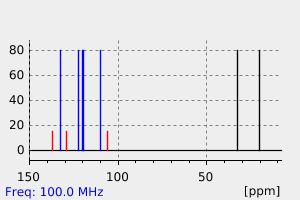1-methyl-3-(methylthio)-1H-indole | 116442-14-9
中文名称
——
中文别名
——
英文名称
1-methyl-3-(methylthio)-1H-indole
英文别名
1-methyl-3-(methylthio)indole;1-methyl-3-methylsulfanylindole
CAS
116442-14-9
化学式
C10H11NS
mdl
MFCD00219117
分子量
177.27
InChiKey
LRPYKXTWLJNQFQ-UHFFFAOYSA-N
BEILSTEIN
——
EINECS
——
-
物化性质
-
计算性质
-
ADMET
-
安全信息
-
SDS
-
制备方法与用途
-
上下游信息
-
文献信息
-
表征谱图
-
同类化合物
-
相关功能分类
-
相关结构分类
计算性质
-
辛醇/水分配系数(LogP):2.8
-
重原子数:12
-
可旋转键数:1
-
环数:2.0
-
sp3杂化的碳原子比例:0.2
-
拓扑面积:30.2
-
氢给体数:0
-
氢受体数:1
安全信息
-
海关编码:2933990090
SDS
上下游信息
反应信息
-
作为反应物:描述:参考文献:名称:吲哚-3-基硫化物的酸催化异构化为吲哚-2-基硫化物:重排的意想不到的分子间性质摘要:质子酸催化的吲哚-3-基硫醚(1)重排为吲哚-2-基硫醚(4),是通过分子间机理意外地进行的,该分子间机理涉及初始歧化成吲哚-2,3-二烷基二硫化物(2)和吲哚(3),然后(2)和(3)之间反应,得到重排产物(4)。DOI:10.1039/c39890000063
-
作为产物:描述:参考文献:名称:Synthesis of methylthiosubstituted heterocycles using the complex of trifluoromethanesulfonic anhydride with dimethyl sulfide摘要:DOI:10.1007/bf02283541
文献信息
-
Switchable regioselection of C–H thiolation of indoles using different TMS counterions
-
Methylthiolation for Electron‐Rich Heteroarenes with DMSO‐TsCl作者:Lei‐Yang Zhang、Yue‐Hua Wu、Nai‐Xing Wang、Xue‐Wang Gao、Zhan Yan、Bao‐Cai Xu、Ning Liu、Bo‐Zhou Wang、Yalan XingDOI:10.1002/ejoc.202100001日期:2021.3.5DMSO‐TsCl is developed for methylthiolation of various heteroarenes including pyrroles, furans, thiophenes and indoles under facile conditions. This protocol features scalable, general applicability of substrates and moderate to excellent yields. An acceptable mechanism is proposed, two of the key intermediates of proposed mechanism are detected by HRMS. Further applications of this method were also
-
Thioether-Directed Selective C4 C–H Alkenylation of Indoles under Rhodium Catalysis作者:Chandrababu Naidu Kona、Yuji Nishii、Masahiro MiuraDOI:10.1021/acs.orglett.8b02038日期:2018.8.17A thioether-directed Rh(III)-catalyzed C4 selective C–H alkenylation of indoles via the formation of 5-membered metallacycle intermediates is reported. This protocol allows a wide functional group compatibility and broad substrate scope. The directing group can be readily removed or transformed into other functional groups after the C–H functionalization event. The catalytic method is also applicable
-
Iridium‐Catalyzed Direct C4‐ and C7‐Selective Alkynylation of Indoles Using Sulfur‐Directing Groups作者:Chandrababu Naidu Kona、Yuji Nishii、Masahiro MiuraDOI:10.1002/anie.201904709日期:2019.7.15past century, and extensive studies have been conducted to establish practical synthetic methods for their derivatives. In particular, selective functionalization of the poorly reactive benzenoid core over the pyrrole ring has been a great challenge. Reported herein is an iridium‐catalyzed direct alkynylation of the indole C4‐ and C7‐positions with the assistance of sulfur directing groups. This transformation
-
DMSO as oxidant and sulfenylating agent for metal-free oxidation and methylthiolation of alcohol-containing indoles作者:Jin-Feng Zou、Wei-Sheng Huang、Li Li、Zheng Xu、Zhan-Jiang Zheng、Ke-Fang Yang、Li-Wen XuDOI:10.1039/c5ra03606b日期:——successfully established for the synthesis of ketone-substituted indoles bearing 3-methylthioether moiety. The new synthetic approach featured metal-free oxidation and methylthiolation of alcohol-containing indoles, in which new C–S bond and CO bond were formed simultaneously using dimethyl sulfoxide as the sulfur source under the Swern oxidation conditions. The methylthiolation reaction provides a simple and
表征谱图
-
氢谱1HNMR
-
质谱MS
-
碳谱13CNMR
-
红外IR
-
拉曼Raman
-
峰位数据
-
峰位匹配
-
表征信息
同类化合物
(Z)-3-[[[2,4-二甲基-3-(乙氧羰基)吡咯-5-基]亚甲基]吲哚-2--2-
(S)-(-)-5'-苄氧基苯基卡维地洛
(R)-(+)-5'-苄氧基卡维地洛
(R)-卡洛芬
(N-(Boc)-2-吲哚基)二甲基硅烷醇钠
(E)-2-氰基-3-(5-(2-辛基-7-(4-(对甲苯基)-1,2,3,3a,4,8b-六氢环戊[b]吲哚-7-基)-2H-苯并[d][1,2,3]三唑-4-基)噻吩-2-基)丙烯酸
(4aS,9bR)-6-溴-2,3,4,4a,5,9b-六氢-1H-吡啶并[4,3-B]吲哚
(3Z)-3-(1H-咪唑-5-基亚甲基)-5-甲氧基-1H-吲哚-2-酮
(3Z)-3-[[[4-(二甲基氨基)苯基]亚甲基]-1H-吲哚-2-酮
(3R)-(-)-3-(1-甲基吲哚-3-基)丁酸甲酯
(3-氯-4,5-二氢-1,2-恶唑-5-基)(1,3-二氧代-1,3-二氢-2H-异吲哚-2-基)乙酸
齐多美辛
鸭脚树叶碱
鸭脚木碱,鸡骨常山碱
鲜麦得新糖
高氯酸1,1’-二(十六烷基)-3,3,3’,3’-四甲基吲哚碳菁
马鲁司特
马鞭草(VERBENAOFFICINALIS)提取物
马来酸阿洛司琼
马来酸替加色罗
顺式-ent-他达拉非
顺式-1,3,4,4a,5,9b-六氢-2H-吡啶并[4,3-b]吲哚-2-甲酸乙酯
顺式-(+-)-3,4-二氢-8-氯-4'-甲基-4-(甲基氨基)-螺(苯并(cd)吲哚-5(1H),2'(5'H)-呋喃)-5'-酮
靛青二磺酸二钾盐
靛藍四磺酸
靛红联二甲酚
靛红磺酸钠
靛红磺酸
靛红乙烯硫代缩酮
靛红-7-甲酸甲酯
靛红-5-磺酸钠
靛红-5-磺酸
靛红-5-硫酸钠盐二水
靛红-5-甲酸甲酯
靛红
靛玉红衍生物E804
靛玉红3'-单肟5-磺酸
靛玉红-3'-单肟
靛玉红
靛噻
青色素3联己酸染料,钾盐
雷马曲班
雷莫司琼杂质13
雷莫司琼杂质12
雷莫司琼杂质
雷替尼卜定
雄甾-1,4-二烯-3,17-二酮
阿霉素的代谢产物盐酸盐
阿贝卡尔
阿西美辛杂质3







